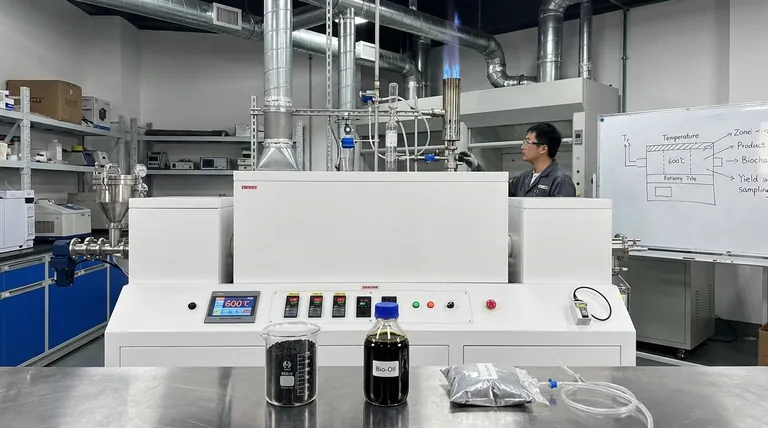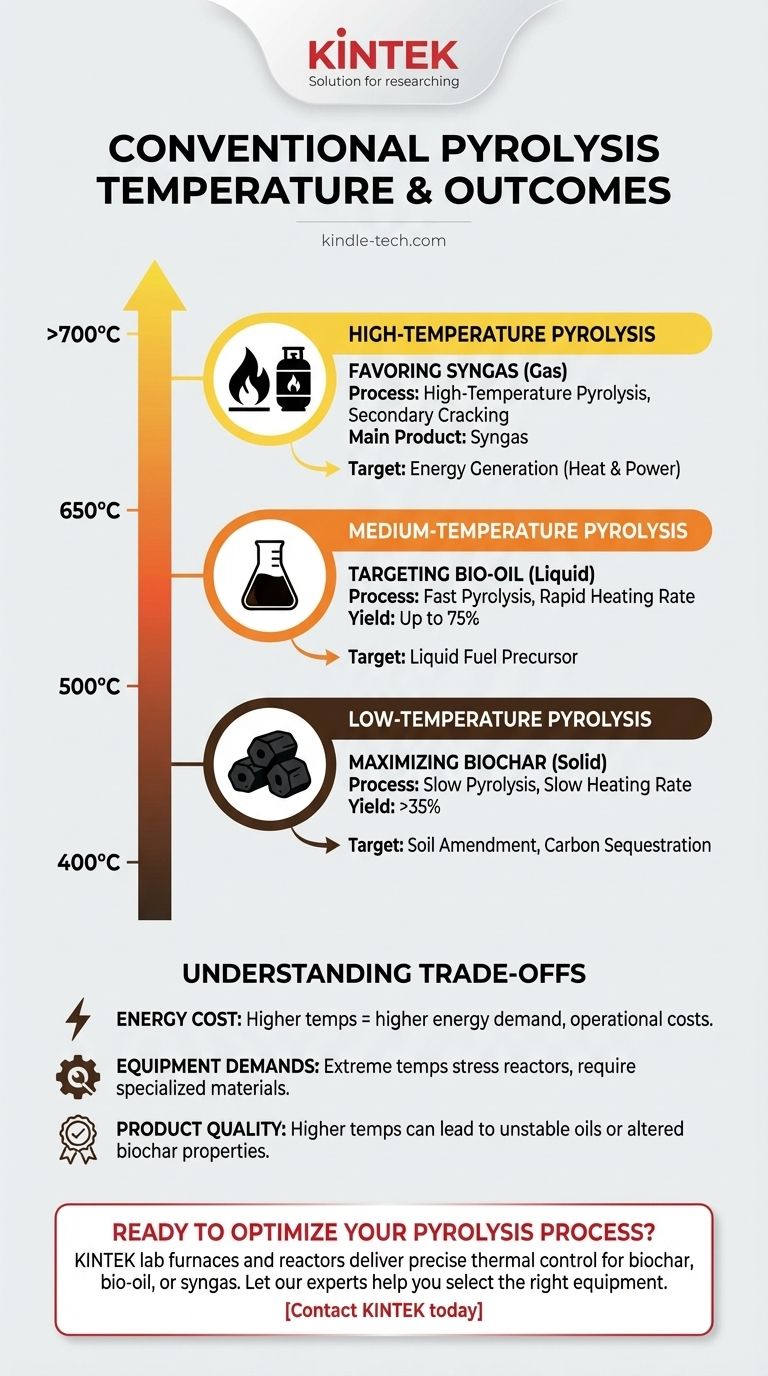Conventional pyrolysis is performed across a wide temperature spectrum, typically between 400°C and 900°C (750°F to 1650°F). This is not a single, fixed number because the temperature is the primary control lever used to determine the final products of the process. The specific temperature chosen depends entirely on whether the goal is to maximize the output of solid biochar, liquid bio-oil, or flammable syngas.
The question isn't what temperature is "correct," but rather what outcome you want to achieve. Lower temperatures favor solid products (biochar), while higher temperatures break down the material further to produce more liquids (bio-oil) and eventually, gases (syngas).

How Temperature Dictates Pyrolysis Outcomes
Pyrolysis is the thermal decomposition of a material in the absence of oxygen. Temperature is the most critical variable in this process, as it directly controls the rate and extent of the chemical reactions that break down the feedstock.
The Role of Temperature in Decomposition
At its core, pyrolysis uses heat to break complex organic polymers into smaller, simpler molecules. As the temperature increases, these decomposition reactions accelerate and become more complete.
Lower temperatures provide enough energy to drive off water and break weaker chemical bonds, leaving behind a carbon-rich solid. Higher temperatures provide the energy needed to crack even the larger, more stable molecules into liquids and gases.
Product Distribution: The Three Key Outputs
The output of pyrolysis is a mixture of three distinct products. The temperature directly determines the ratio of these outputs.
- Biochar: A stable, carbon-rich solid similar to charcoal.
- Bio-oil: A dense, acidic liquid also known as pyrolysis oil or tar.
- Syngas: A mixture of flammable, non-condensable gases like hydrogen, carbon monoxide, and methane.
Mapping Temperature to Desired Products
By selecting a specific temperature range, operators can steer the pyrolysis reaction to favor one product over the others. "Conventional" pyrolysis can refer to any of these regimes, depending on the industry and goal.
Low-Temperature Pyrolysis (< 500°C): Maximizing Biochar
Operating at lower temperatures with a slower heating rate is often called slow pyrolysis. This process maximizes the yield of biochar.
The milder conditions preserve more of the fixed carbon in a solid structure, resulting in biochar yields that can exceed 35% by weight. This is the preferred method for producing charcoal or biochar for agricultural and environmental applications.
Medium-Temperature Pyrolysis (500-700°C): Targeting Bio-oil
This temperature range is the sweet spot for maximizing the production of bio-oil. This process is often called fast pyrolysis because it combines moderate temperatures with very rapid heating rates.
These conditions are optimized to break down the feedstock into vapors and aerosols which, when rapidly cooled and condensed, form a liquid bio-oil. Yields can reach up to 75% by weight, though this requires very precise control over heating and residence time.
High-Temperature Pyrolysis (> 700°C): Favoring Syngas
At temperatures above 700°C, the process enters a stage of secondary cracking. The long-chain molecules present in bio-oil become unstable and break down further into smaller, permanent gas molecules.
This significantly increases the yield of syngas, making it the primary product. This approach, sometimes called gasification (though true gasification involves an oxidizing agent), is used when the goal is to produce a fuel gas for generating heat and power.
Understanding the Trade-offs
Choosing a temperature is an engineering decision with significant consequences for the process's efficiency, cost, and complexity.
The Energy Cost
Higher temperatures demand significantly more energy input. This increases operational costs and can negatively impact the overall net energy balance of the system. A process that consumes more energy than it produces is rarely economically viable.
Equipment and Material Demands
Operating at extreme temperatures places immense stress on the pyrolysis reactor and associated equipment. It necessitates the use of specialized alloys and refractory materials that can withstand the heat and corrosive environment, adding to the capital cost.
Product Quality and Stability
Higher temperatures do not always mean better products. For example, bio-oils produced at very high temperatures can be unstable and difficult to upgrade into usable fuels. The properties of biochar, such as its porosity and surface area, are also heavily dependent on the temperature at which it was created.
Selecting the Right Temperature for Your Goal
The optimal pyrolysis temperature is defined by your end goal. Before starting any project, clearly define which output product holds the most value for your application.
- If your primary focus is producing biochar for soil amendment or carbon sequestration: Operate at lower temperatures (400-550°C) with slow heating rates to maximize solid yield.
- If your primary focus is generating bio-oil as a liquid fuel precursor: Target medium temperatures (around 500-650°C) combined with very fast heating rates to optimize liquid condensation.
- If your primary focus is creating syngas for energy generation: Use high temperatures (above 700°C) to ensure the complete thermal cracking of heavier molecules into gas.
Ultimately, temperature is the tool you use to tell the feedstock what you want it to become.
Summary Table:
| Target Product | Optimal Temperature Range | Key Process Characteristic |
|---|---|---|
| Biochar (Solid) | 400°C - 550°C | Slow Pyrolysis / Slow Heating Rate |
| Bio-Oil (Liquid) | 500°C - 650°C | Fast Pyrolysis / Rapid Heating Rate |
| Syngas (Gas) | > 700°C | High-Temperature Pyrolysis / Secondary Cracking |
Ready to design your pyrolysis process for maximum yield? The precise temperature control of your reactor is critical to achieving your target product, whether it's biochar, bio-oil, or syngas. KINTEK specializes in high-quality lab furnaces and pyrolysis reactors that deliver the exact thermal profiles and reliability your R&D or production needs. Let our experts help you select the right equipment for your specific application. Contact KINTEK today to discuss your project requirements.
Visual Guide

Related Products
- Vacuum Sealed Continuous Working Rotary Tube Furnace Rotating Tube Furnace
- Electric Rotary Kiln Small Rotary Furnace Biomass Pyrolysis Plant
- High Pressure Laboratory Vacuum Tube Furnace Quartz Tubular Furnace
- Laboratory Muffle Oven Furnace Bottom Lifting Muffle Furnace
- 1200℃ Split Tube Furnace with Quartz Tube Laboratory Tubular Furnace
People Also Ask
- What is the temperature of a rotary hearth furnace? Find the Right Heat for Your Process
- What temperature is needed for pyrolysis waste? A Guide to Optimizing Your Waste-to-Value Process
- What are the main types of biomass conversion processes? Unlock the Best Pathway for Your Energy Needs
- What are the factors affecting the yield of bio-oil from the pyrolysis of coconut shell? Control 4 Key Parameters
- What is the range of pyrolysis? Master Temperature Control for Optimal Bio-Product Yields



















